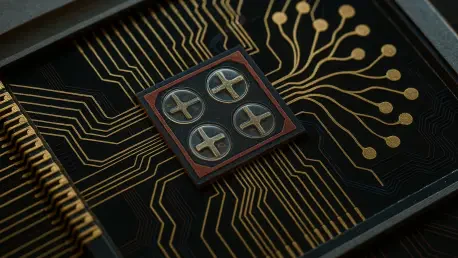In an era where artificial intelligence (AI) demands unprecedented computational power, the energy consumption of traditional silicon-based systems has become a staggering bottleneck, with data centers alone accounting for nearly 2% of global electricity usage, driving researchers to explore innovative architectures that mimic the efficiency of the human brain. Enter scalable memtransistor arrays, a groundbreaking technology leveraging ultra-thin two-dimensional (2D) materials to combine data storage and processing in a single unit. This review delves into the transformative potential of memtransistor arrays, examining their design, performance, and role in revolutionizing energy-efficient computing for AI applications.
Understanding Memtransistor Technology
Memtransistor technology represents a paradigm shift in electronics by integrating memory and transistor functions into one compact device. Built primarily from transition metal dichalcogenide (TMDC) materials like molybdenum disulfide (MoS2), these devices operate on the principle of resistive switching, enabling them to store data while simultaneously processing signals. This dual functionality addresses the inefficiencies of conventional systems where memory and computation are separated, creating delays and high power demands.
The emergence of memtransistors responds directly to the limitations of silicon-based architectures, particularly in handling the massive parallel processing required for AI workloads. By emulating synaptic behavior in the human brain, these devices offer a pathway to neuromorphic computing, where learning and adaptation occur at the hardware level. Their ultra-thin 2D structure further enhances their suitability for high-density integration, setting the stage for compact and scalable solutions.
Key Innovations in Memtransistor Array Design
Schottky Barrier Modulation
A critical advancement in memtransistor arrays lies in the precise control of Schottky barriers, interfaces that regulate electrical flow within the device. By selectively exposing areas of MoS2 to oxygen, researchers create controlled sulfur vacancies that fine-tune these barriers, ensuring consistent and predictable electrical behavior across large arrays. This innovation is pivotal for achieving uniformity, a long-standing hurdle in scaling such technologies.
This method not only enhances device reliability but also significantly boosts scalability. Uniform electrical characteristics mean that thousands of memtransistors can operate in sync without performance degradation, a necessity for practical artificial neural networks (ANNs). The impact on overall efficiency is profound, as it minimizes variations that could otherwise disrupt complex computations.
Compact Design and Miniaturization
Another standout feature of these arrays is their remarkably compact design, with a channel length of just 500 nanometers and a cell size as small as 4.65 F²—a measure of area in semiconductor design. Such miniaturization allows for an exceptionally high density of devices on a single chip, making it feasible to build large-scale systems without sacrificing space. This compactness is essential for real-world applications where physical constraints often limit hardware expansion.
Beyond size, the design maintains robust performance even at reduced scales, a testament to the meticulous engineering behind it. This balance of small footprint and high functionality positions memtransistor arrays as ideal candidates for integration into next-generation AI hardware, where both efficiency and power are paramount.
Recent Developments in Neuromorphic Computing
The field of neuromorphic computing is witnessing a decisive shift toward 2D materials as the foundation for energy-efficient electronics. Memtransistor arrays exemplify this trend, offering a viable alternative to silicon by reducing power consumption while enhancing computational speed. Recent innovations focus on refining these arrays to meet the rigorous demands of AI, particularly in handling vast datasets with minimal energy overhead.
Scalability and uniformity remain key areas of progress, with ongoing research tackling historical inconsistencies in device behavior. Industry-wide, there is a noticeable pivot away from traditional architectures, driven by the need to support increasingly complex algorithms. Memtransistor technology stands at the forefront of this transition, promising to redefine how computational tasks are approached in modern systems.
Real-World Applications of Memtransistor Arrays
Memtransistor arrays have already demonstrated impressive practical utility, particularly in ANNs for tasks such as image recognition, where they achieve accuracy rates exceeding 98%. This high performance underscores their potential as core components in AI accelerators, which are critical for applications ranging from autonomous vehicles to medical diagnostics. The ability to process and classify data with such precision opens new possibilities in diverse sectors.
Additionally, the versatility of the technology extends across various TMDC materials beyond MoS2, such as molybdenum ditelluride, broadening its applicability. Successful implementations highlight the adaptability of these arrays, whether in experimental setups or early commercial integrations. Their role in enabling faster, more efficient AI systems is becoming increasingly evident as adoption grows.
Challenges and Limitations in Memtransistor Scaling
Despite the promise, scaling memtransistor technology to commercial levels faces notable obstacles. Historically, issues such as inconsistent resistive switching ratios and poor device-to-device uniformity have hampered progress, often resulting in unreliable performance across arrays. Low fabrication yields have further complicated efforts to produce these devices at scale, limiting their immediate impact.
Current technical hurdles include maintaining performance consistency as arrays grow larger and more complex. While recent advancements have mitigated some variability, achieving seamless manufacturability remains a work in progress. Continuous efforts are underway to refine fabrication processes and enhance material stability, aiming to ensure that memtransistor arrays can meet the stringent demands of widespread deployment.
Future Outlook for Memtransistor Technology
Looking ahead, the horizon for memtransistor arrays is filled with exciting possibilities, including integration with multi-layer stacking to increase computational density. Hybrid architectures combining CMOS and 2D materials could also emerge, blending the strengths of established technologies with cutting-edge innovations. Such developments are poised to push the boundaries of what neuromorphic systems can achieve over the next few years, from 2025 to 2027.
The long-term impact on AI system design is expected to be transformative, with energy efficiency becoming a cornerstone of future computing platforms. As these arrays evolve, their ability to mimic intricate brain functions could lead to breakthroughs in adaptive learning and real-time processing. The trajectory suggests a pivotal role in shaping the next generation of intelligent hardware.
Final Thoughts
Reflecting on this exploration, the journey of scalable memtransistor arrays proves to be a remarkable stride in neuromorphic computing, with their ability to deliver high accuracy and uniformity setting a new benchmark. Their compact design and innovative Schottky barrier modulation tackle critical barriers that once seemed insurmountable. Moving forward, the focus should shift to accelerating fabrication advancements and exploring hybrid integrations to unlock even greater potential. Collaboration between academia and industry will be essential to refine these technologies, ensuring they transition smoothly from research labs to real-world systems. The path ahead demands sustained investment in overcoming remaining scalability challenges, paving the way for a future where energy-efficient AI hardware becomes the norm.









